MGMT20140 Reflective Report: Design Thinking and Learning Journey
VerifiedAdded on 2023/01/18
|11
|3579
|25
Report
AI Summary
This reflective report analyzes a student's learning journey in design thinking, focusing on personal and knowledge development over several weeks. The report examines critical self-analysis, including strengths and weaknesses, and reflects on the application of design thinking tools like journey mapping, value chain analysis, and mind mapping. The student identifies areas for improvement in communication and creative thinking, utilizing interview processes and rapid prototyping. The report includes an action plan for skill enhancement and provides insights into the student's growth, referencing blog entries and academic literature. It also covers the knowledge gained on various concepts related to design thinking, customer analysis, and the interview process.
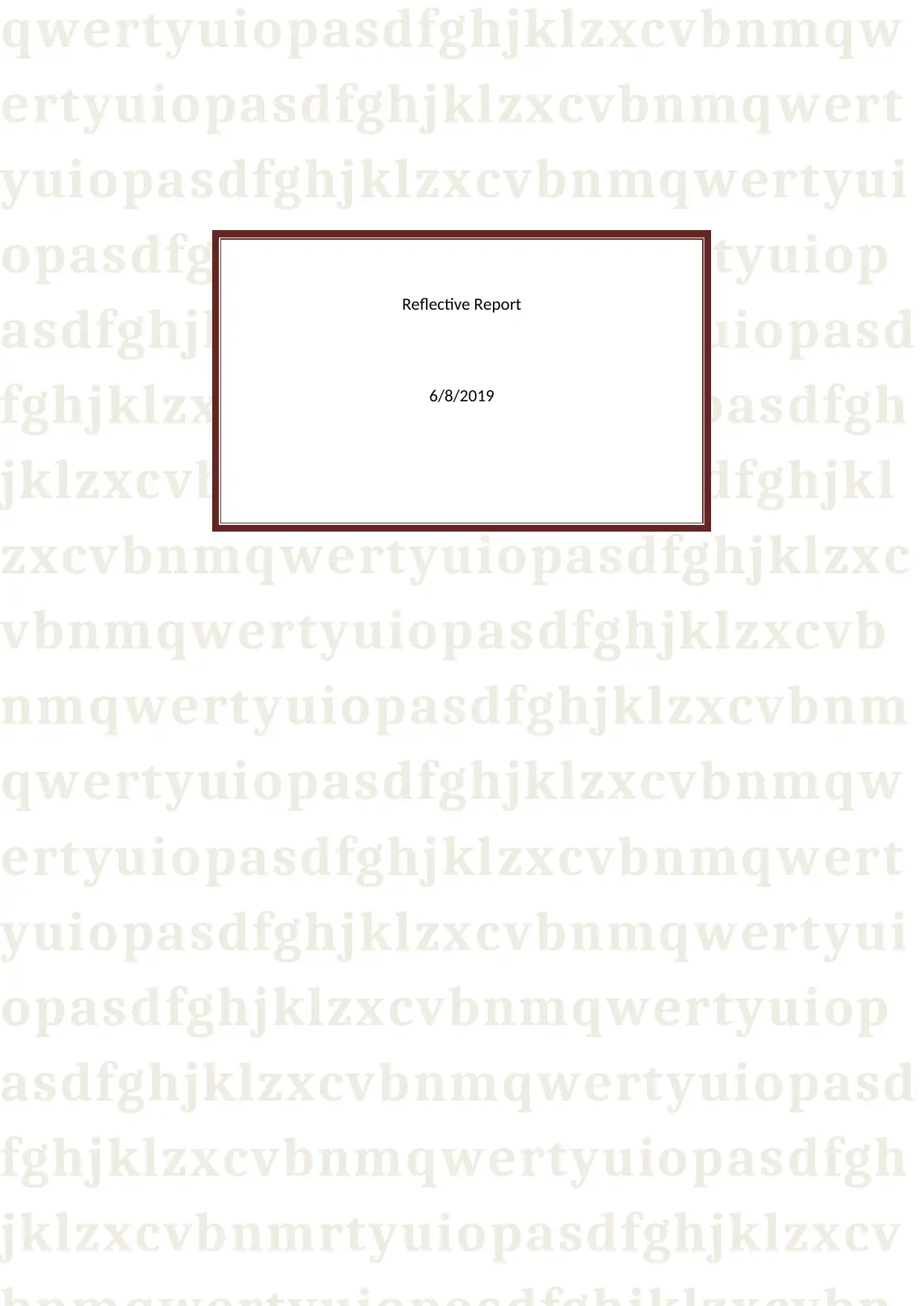
qwertyuiopasdfghjklzxcvbnmqw
ertyuiopasdfghjklzxcvbnmqwert
yuiopasdfghjklzxcvbnmqwertyui
opasdfghjklzxcvbnmqwertyuiop
asdfghjklzxcvbnmqwertyuiopasd
fghjklzxcvbnmqwertyuiopasdfgh
jklzxcvbnmqwertyuiopasdfghjkl
zxcvbnmqwertyuiopasdfghjklzxc
vbnmqwertyuiopasdfghjklzxcvb
nmqwertyuiopasdfghjklzxcvbnm
qwertyuiopasdfghjklzxcvbnmqw
ertyuiopasdfghjklzxcvbnmqwert
yuiopasdfghjklzxcvbnmqwertyui
opasdfghjklzxcvbnmqwertyuiop
asdfghjklzxcvbnmqwertyuiopasd
fghjklzxcvbnmqwertyuiopasdfgh
jklzxcvbnmrtyuiopasdfghjklzxcv
Reflective Report
6/8/2019
ertyuiopasdfghjklzxcvbnmqwert
yuiopasdfghjklzxcvbnmqwertyui
opasdfghjklzxcvbnmqwertyuiop
asdfghjklzxcvbnmqwertyuiopasd
fghjklzxcvbnmqwertyuiopasdfgh
jklzxcvbnmqwertyuiopasdfghjkl
zxcvbnmqwertyuiopasdfghjklzxc
vbnmqwertyuiopasdfghjklzxcvb
nmqwertyuiopasdfghjklzxcvbnm
qwertyuiopasdfghjklzxcvbnmqw
ertyuiopasdfghjklzxcvbnmqwert
yuiopasdfghjklzxcvbnmqwertyui
opasdfghjklzxcvbnmqwertyuiop
asdfghjklzxcvbnmqwertyuiopasd
fghjklzxcvbnmqwertyuiopasdfgh
jklzxcvbnmrtyuiopasdfghjklzxcv
Reflective Report
6/8/2019
Paraphrase This Document
Need a fresh take? Get an instant paraphrase of this document with our AI Paraphraser
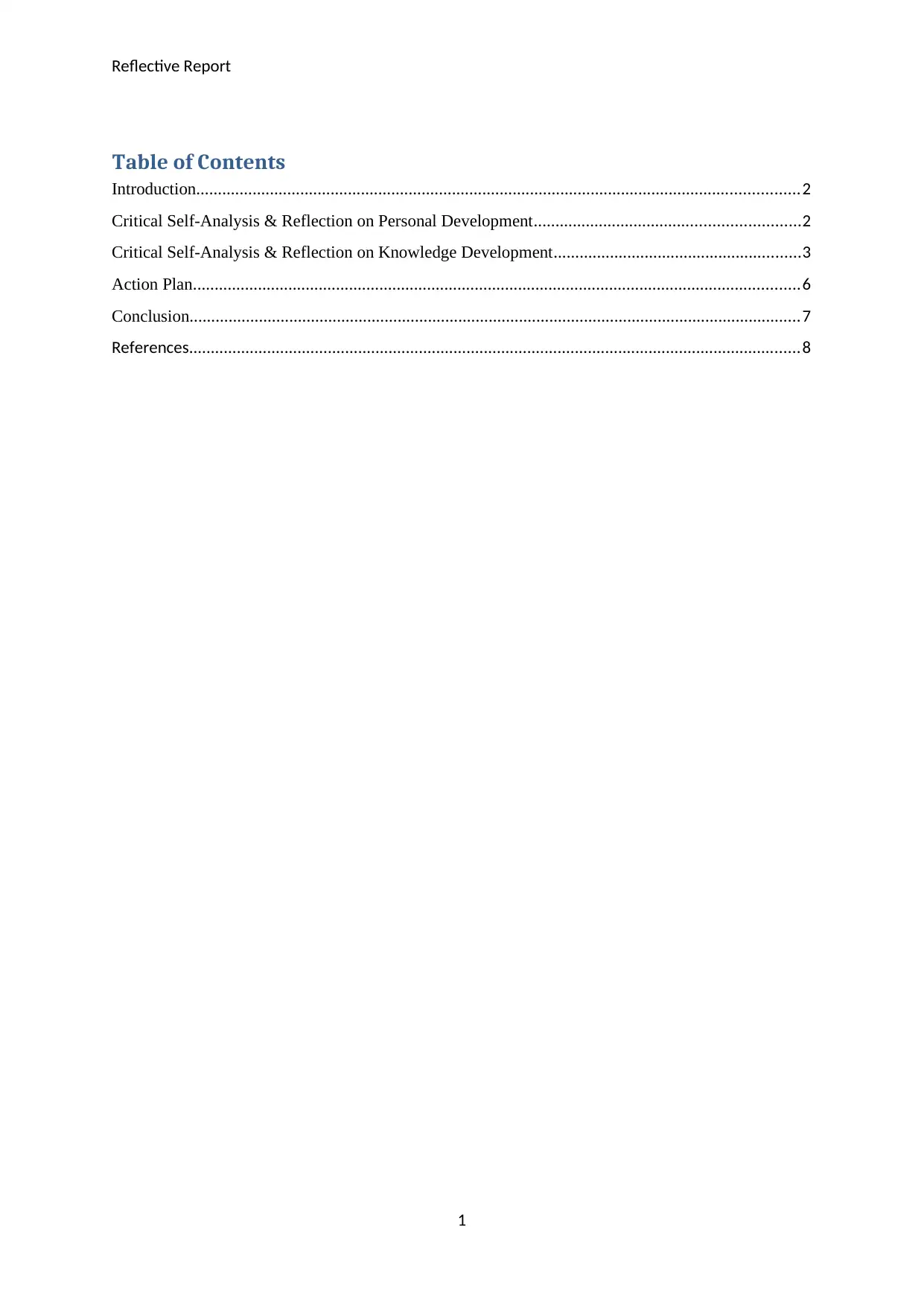
Reflective Report
Table of Contents
Introduction...........................................................................................................................................2
Critical Self-Analysis & Reflection on Personal Development.............................................................2
Critical Self-Analysis & Reflection on Knowledge Development.........................................................3
Action Plan............................................................................................................................................6
Conclusion.............................................................................................................................................7
References.............................................................................................................................................8
1
Table of Contents
Introduction...........................................................................................................................................2
Critical Self-Analysis & Reflection on Personal Development.............................................................2
Critical Self-Analysis & Reflection on Knowledge Development.........................................................3
Action Plan............................................................................................................................................6
Conclusion.............................................................................................................................................7
References.............................................................................................................................................8
1
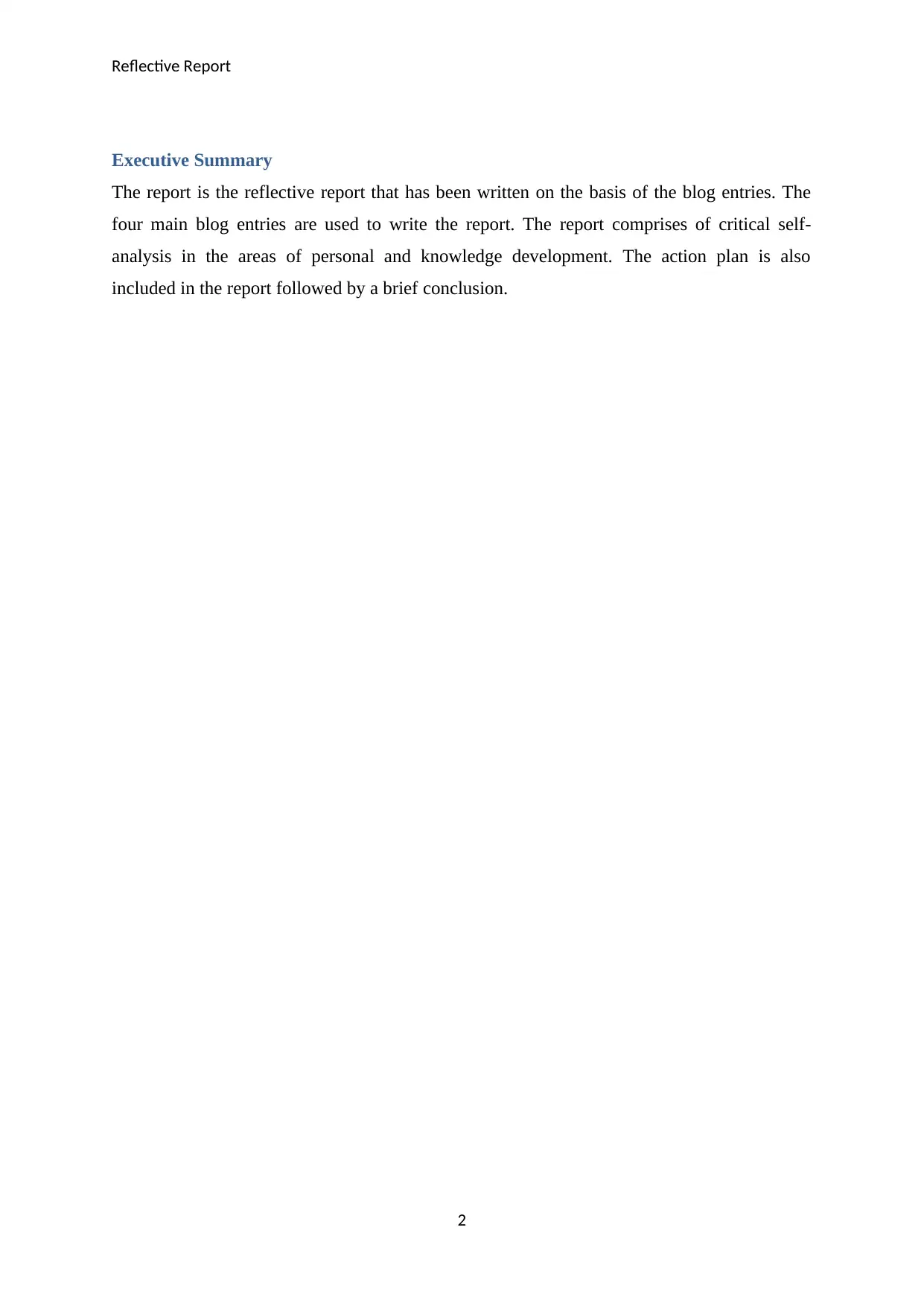
Reflective Report
Executive Summary
The report is the reflective report that has been written on the basis of the blog entries. The
four main blog entries are used to write the report. The report comprises of critical self-
analysis in the areas of personal and knowledge development. The action plan is also
included in the report followed by a brief conclusion.
2
Executive Summary
The report is the reflective report that has been written on the basis of the blog entries. The
four main blog entries are used to write the report. The report comprises of critical self-
analysis in the areas of personal and knowledge development. The action plan is also
included in the report followed by a brief conclusion.
2
⊘ This is a preview!⊘
Do you want full access?
Subscribe today to unlock all pages.

Trusted by 1+ million students worldwide

Reflective Report
Introduction
Reflective writing is a practice that includes the analysis and reflection on the activities done
in the past. It provides the ability to understand the strengths and positive aspects associated
with these activities and also provide the opportunities to understand the areas for
improvement (Harerimana, 2018). I have used the blog entries for weeks 3, 4, 5, and 6 to
reflect upon the tasks done and come up with the key learnings in terms of personal and
knowledge development. I have documented the action plan on the basis of these findings.
Critical Self-Analysis & Reflection on Personal Development
In the third week, I got the opportunity to gain some new experiences and enhance the
creative side. The primary activities that I and my group did in this week included journey
mapping and brainstorming. We basically did these activities associated with the post-
graduation course in Australia. Design thinking was the main focus of the activity and there
were certain lessons that I could acquire in the process (Oxman, 2017). I got the opportunity
to understand the areas that I needed to improve upon in terms of design thinking and
application of tools in the same. I had not done journey mapping earlier; however, I was a
part of the brainstorming activities prior to this experience. We had interactions within the
group during the process of journey mapping and I could connect the information with the
associated sets. I was able to draw conclusions from the information that was brought up and
also contributed in the process by providing the suggestions. I could succeed in exploring the
creative side; however, I believe that it is one area that I could improve upon. I felt that I need
to be more creative in terms of the utilization and application of the tools in the field of
design thinking (Mosely, Wright & Wrigley, 2018).
In the fourth week, I utilized the tools as value chain and mind mapping. I had no prior
experience on any of these tools. I was provided with a brief on the two tools and I could
perform fairly well. There was development of skills and abilities that I could experience
with the use of the tools. I made use of the case study for an organization called Iconic and
could apply the innovative thinking and skills to determine the demands of the customers and
their expectations using the value chain analysis (Khurum, Petersen & Gorschek, 2014). I
was also aware of the fact that the organizations always work towards the expectations set up
by the customers and therefore, the organizations must be clear on the customer preferences
and choices. I made use of the value chain tool to determine the customer priorities. I was
3
Introduction
Reflective writing is a practice that includes the analysis and reflection on the activities done
in the past. It provides the ability to understand the strengths and positive aspects associated
with these activities and also provide the opportunities to understand the areas for
improvement (Harerimana, 2018). I have used the blog entries for weeks 3, 4, 5, and 6 to
reflect upon the tasks done and come up with the key learnings in terms of personal and
knowledge development. I have documented the action plan on the basis of these findings.
Critical Self-Analysis & Reflection on Personal Development
In the third week, I got the opportunity to gain some new experiences and enhance the
creative side. The primary activities that I and my group did in this week included journey
mapping and brainstorming. We basically did these activities associated with the post-
graduation course in Australia. Design thinking was the main focus of the activity and there
were certain lessons that I could acquire in the process (Oxman, 2017). I got the opportunity
to understand the areas that I needed to improve upon in terms of design thinking and
application of tools in the same. I had not done journey mapping earlier; however, I was a
part of the brainstorming activities prior to this experience. We had interactions within the
group during the process of journey mapping and I could connect the information with the
associated sets. I was able to draw conclusions from the information that was brought up and
also contributed in the process by providing the suggestions. I could succeed in exploring the
creative side; however, I believe that it is one area that I could improve upon. I felt that I need
to be more creative in terms of the utilization and application of the tools in the field of
design thinking (Mosely, Wright & Wrigley, 2018).
In the fourth week, I utilized the tools as value chain and mind mapping. I had no prior
experience on any of these tools. I was provided with a brief on the two tools and I could
perform fairly well. There was development of skills and abilities that I could experience
with the use of the tools. I made use of the case study for an organization called Iconic and
could apply the innovative thinking and skills to determine the demands of the customers and
their expectations using the value chain analysis (Khurum, Petersen & Gorschek, 2014). I
was also aware of the fact that the organizations always work towards the expectations set up
by the customers and therefore, the organizations must be clear on the customer preferences
and choices. I made use of the value chain tool to determine the customer priorities. I was
3
Paraphrase This Document
Need a fresh take? Get an instant paraphrase of this document with our AI Paraphraser
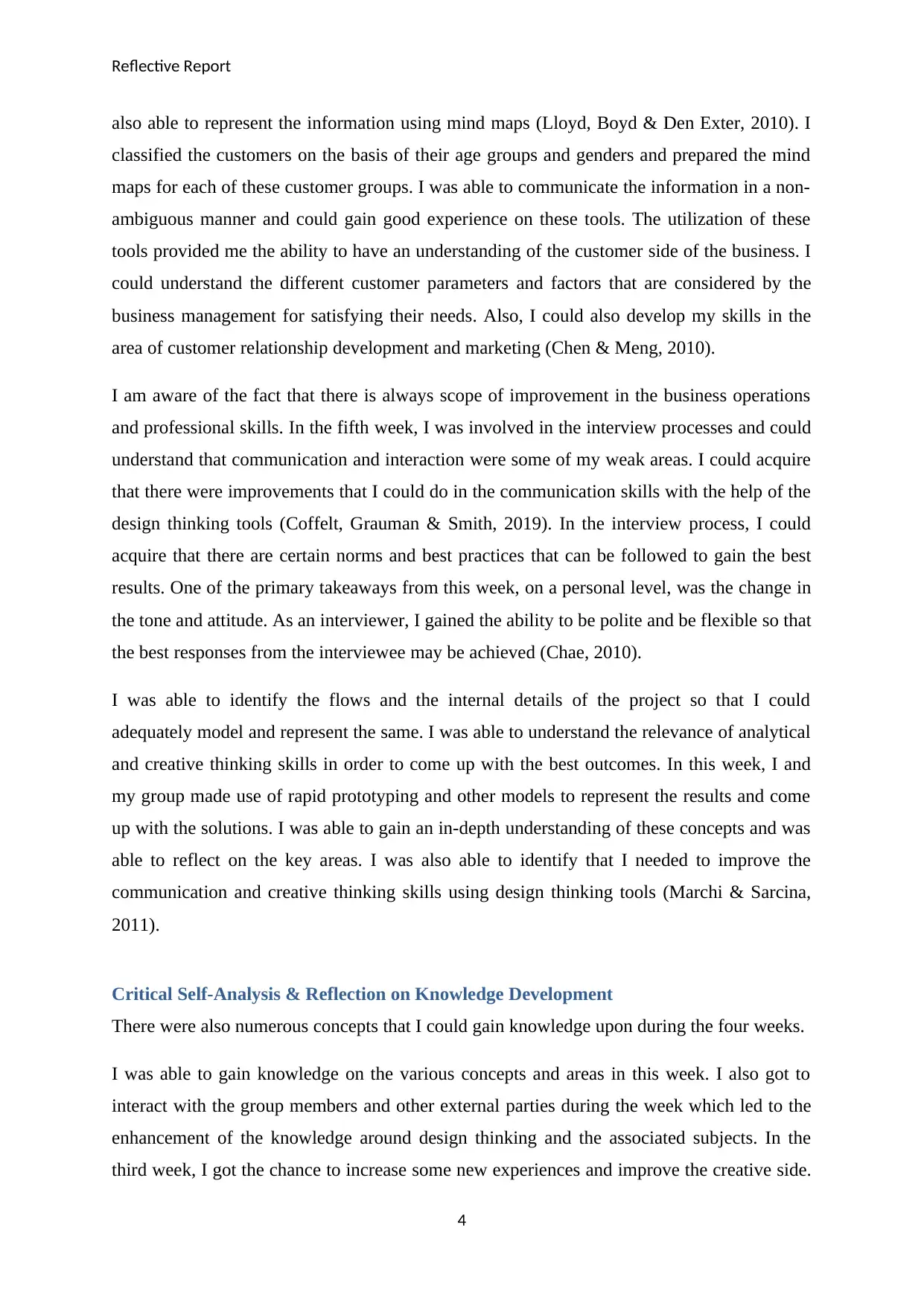
Reflective Report
also able to represent the information using mind maps (Lloyd, Boyd & Den Exter, 2010). I
classified the customers on the basis of their age groups and genders and prepared the mind
maps for each of these customer groups. I was able to communicate the information in a non-
ambiguous manner and could gain good experience on these tools. The utilization of these
tools provided me the ability to have an understanding of the customer side of the business. I
could understand the different customer parameters and factors that are considered by the
business management for satisfying their needs. Also, I could also develop my skills in the
area of customer relationship development and marketing (Chen & Meng, 2010).
I am aware of the fact that there is always scope of improvement in the business operations
and professional skills. In the fifth week, I was involved in the interview processes and could
understand that communication and interaction were some of my weak areas. I could acquire
that there were improvements that I could do in the communication skills with the help of the
design thinking tools (Coffelt, Grauman & Smith, 2019). In the interview process, I could
acquire that there are certain norms and best practices that can be followed to gain the best
results. One of the primary takeaways from this week, on a personal level, was the change in
the tone and attitude. As an interviewer, I gained the ability to be polite and be flexible so that
the best responses from the interviewee may be achieved (Chae, 2010).
I was able to identify the flows and the internal details of the project so that I could
adequately model and represent the same. I was able to understand the relevance of analytical
and creative thinking skills in order to come up with the best outcomes. In this week, I and
my group made use of rapid prototyping and other models to represent the results and come
up with the solutions. I was able to gain an in-depth understanding of these concepts and was
able to reflect on the key areas. I was also able to identify that I needed to improve the
communication and creative thinking skills using design thinking tools (Marchi & Sarcina,
2011).
Critical Self-Analysis & Reflection on Knowledge Development
There were also numerous concepts that I could gain knowledge upon during the four weeks.
I was able to gain knowledge on the various concepts and areas in this week. I also got to
interact with the group members and other external parties during the week which led to the
enhancement of the knowledge around design thinking and the associated subjects. In the
third week, I got the chance to increase some new experiences and improve the creative side.
4
also able to represent the information using mind maps (Lloyd, Boyd & Den Exter, 2010). I
classified the customers on the basis of their age groups and genders and prepared the mind
maps for each of these customer groups. I was able to communicate the information in a non-
ambiguous manner and could gain good experience on these tools. The utilization of these
tools provided me the ability to have an understanding of the customer side of the business. I
could understand the different customer parameters and factors that are considered by the
business management for satisfying their needs. Also, I could also develop my skills in the
area of customer relationship development and marketing (Chen & Meng, 2010).
I am aware of the fact that there is always scope of improvement in the business operations
and professional skills. In the fifth week, I was involved in the interview processes and could
understand that communication and interaction were some of my weak areas. I could acquire
that there were improvements that I could do in the communication skills with the help of the
design thinking tools (Coffelt, Grauman & Smith, 2019). In the interview process, I could
acquire that there are certain norms and best practices that can be followed to gain the best
results. One of the primary takeaways from this week, on a personal level, was the change in
the tone and attitude. As an interviewer, I gained the ability to be polite and be flexible so that
the best responses from the interviewee may be achieved (Chae, 2010).
I was able to identify the flows and the internal details of the project so that I could
adequately model and represent the same. I was able to understand the relevance of analytical
and creative thinking skills in order to come up with the best outcomes. In this week, I and
my group made use of rapid prototyping and other models to represent the results and come
up with the solutions. I was able to gain an in-depth understanding of these concepts and was
able to reflect on the key areas. I was also able to identify that I needed to improve the
communication and creative thinking skills using design thinking tools (Marchi & Sarcina,
2011).
Critical Self-Analysis & Reflection on Knowledge Development
There were also numerous concepts that I could gain knowledge upon during the four weeks.
I was able to gain knowledge on the various concepts and areas in this week. I also got to
interact with the group members and other external parties during the week which led to the
enhancement of the knowledge around design thinking and the associated subjects. In the
third week, I got the chance to increase some new experiences and improve the creative side.
4
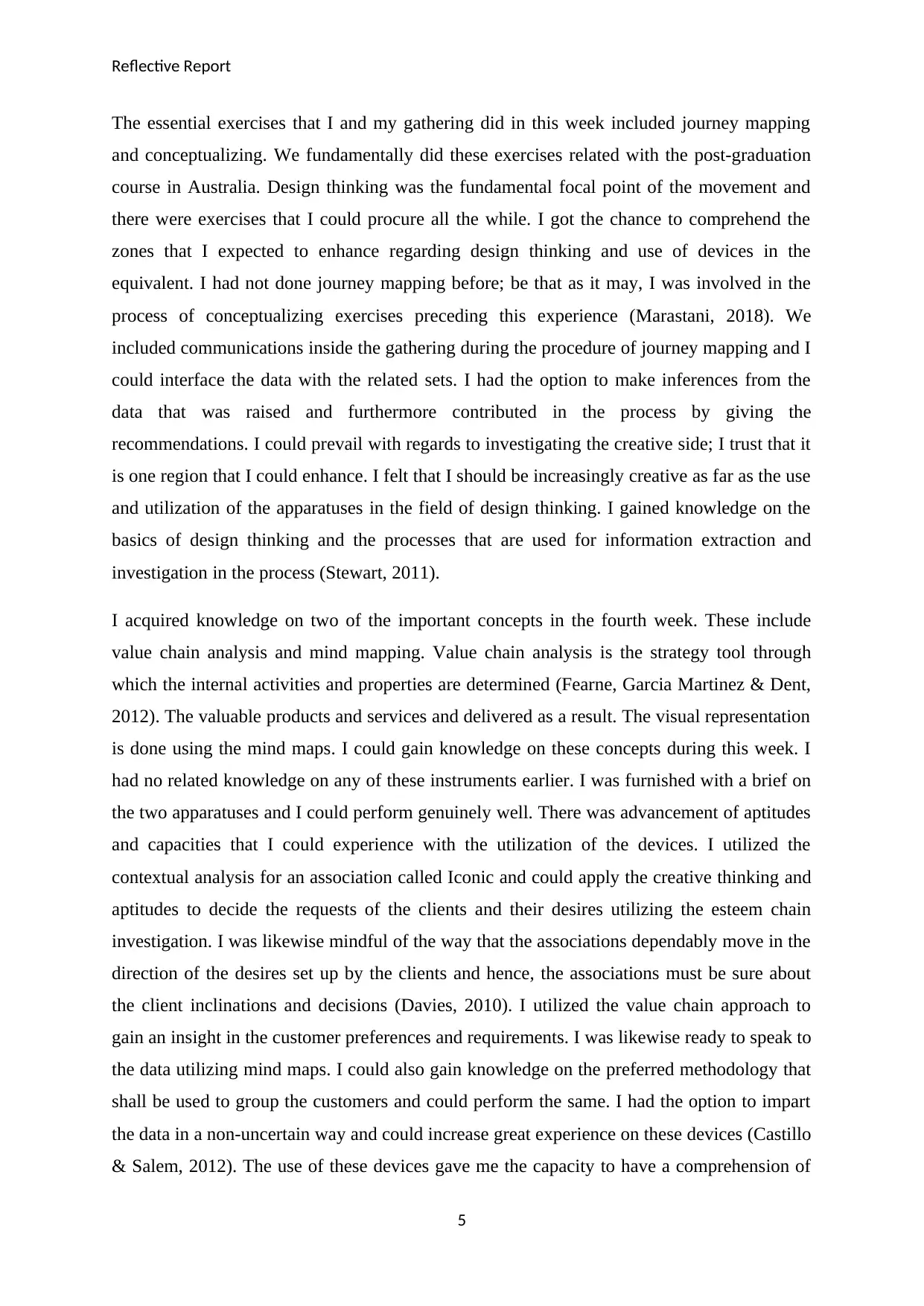
Reflective Report
The essential exercises that I and my gathering did in this week included journey mapping
and conceptualizing. We fundamentally did these exercises related with the post-graduation
course in Australia. Design thinking was the fundamental focal point of the movement and
there were exercises that I could procure all the while. I got the chance to comprehend the
zones that I expected to enhance regarding design thinking and use of devices in the
equivalent. I had not done journey mapping before; be that as it may, I was involved in the
process of conceptualizing exercises preceding this experience (Marastani, 2018). We
included communications inside the gathering during the procedure of journey mapping and I
could interface the data with the related sets. I had the option to make inferences from the
data that was raised and furthermore contributed in the process by giving the
recommendations. I could prevail with regards to investigating the creative side; I trust that it
is one region that I could enhance. I felt that I should be increasingly creative as far as the use
and utilization of the apparatuses in the field of design thinking. I gained knowledge on the
basics of design thinking and the processes that are used for information extraction and
investigation in the process (Stewart, 2011).
I acquired knowledge on two of the important concepts in the fourth week. These include
value chain analysis and mind mapping. Value chain analysis is the strategy tool through
which the internal activities and properties are determined (Fearne, Garcia Martinez & Dent,
2012). The valuable products and services and delivered as a result. The visual representation
is done using the mind maps. I could gain knowledge on these concepts during this week. I
had no related knowledge on any of these instruments earlier. I was furnished with a brief on
the two apparatuses and I could perform genuinely well. There was advancement of aptitudes
and capacities that I could experience with the utilization of the devices. I utilized the
contextual analysis for an association called Iconic and could apply the creative thinking and
aptitudes to decide the requests of the clients and their desires utilizing the esteem chain
investigation. I was likewise mindful of the way that the associations dependably move in the
direction of the desires set up by the clients and hence, the associations must be sure about
the client inclinations and decisions (Davies, 2010). I utilized the value chain approach to
gain an insight in the customer preferences and requirements. I was likewise ready to speak to
the data utilizing mind maps. I could also gain knowledge on the preferred methodology that
shall be used to group the customers and could perform the same. I had the option to impart
the data in a non-uncertain way and could increase great experience on these devices (Castillo
& Salem, 2012). The use of these devices gave me the capacity to have a comprehension of
5
The essential exercises that I and my gathering did in this week included journey mapping
and conceptualizing. We fundamentally did these exercises related with the post-graduation
course in Australia. Design thinking was the fundamental focal point of the movement and
there were exercises that I could procure all the while. I got the chance to comprehend the
zones that I expected to enhance regarding design thinking and use of devices in the
equivalent. I had not done journey mapping before; be that as it may, I was involved in the
process of conceptualizing exercises preceding this experience (Marastani, 2018). We
included communications inside the gathering during the procedure of journey mapping and I
could interface the data with the related sets. I had the option to make inferences from the
data that was raised and furthermore contributed in the process by giving the
recommendations. I could prevail with regards to investigating the creative side; I trust that it
is one region that I could enhance. I felt that I should be increasingly creative as far as the use
and utilization of the apparatuses in the field of design thinking. I gained knowledge on the
basics of design thinking and the processes that are used for information extraction and
investigation in the process (Stewart, 2011).
I acquired knowledge on two of the important concepts in the fourth week. These include
value chain analysis and mind mapping. Value chain analysis is the strategy tool through
which the internal activities and properties are determined (Fearne, Garcia Martinez & Dent,
2012). The valuable products and services and delivered as a result. The visual representation
is done using the mind maps. I could gain knowledge on these concepts during this week. I
had no related knowledge on any of these instruments earlier. I was furnished with a brief on
the two apparatuses and I could perform genuinely well. There was advancement of aptitudes
and capacities that I could experience with the utilization of the devices. I utilized the
contextual analysis for an association called Iconic and could apply the creative thinking and
aptitudes to decide the requests of the clients and their desires utilizing the esteem chain
investigation. I was likewise mindful of the way that the associations dependably move in the
direction of the desires set up by the clients and hence, the associations must be sure about
the client inclinations and decisions (Davies, 2010). I utilized the value chain approach to
gain an insight in the customer preferences and requirements. I was likewise ready to speak to
the data utilizing mind maps. I could also gain knowledge on the preferred methodology that
shall be used to group the customers and could perform the same. I had the option to impart
the data in a non-uncertain way and could increase great experience on these devices (Castillo
& Salem, 2012). The use of these devices gave me the capacity to have a comprehension of
5
⊘ This is a preview!⊘
Do you want full access?
Subscribe today to unlock all pages.

Trusted by 1+ million students worldwide
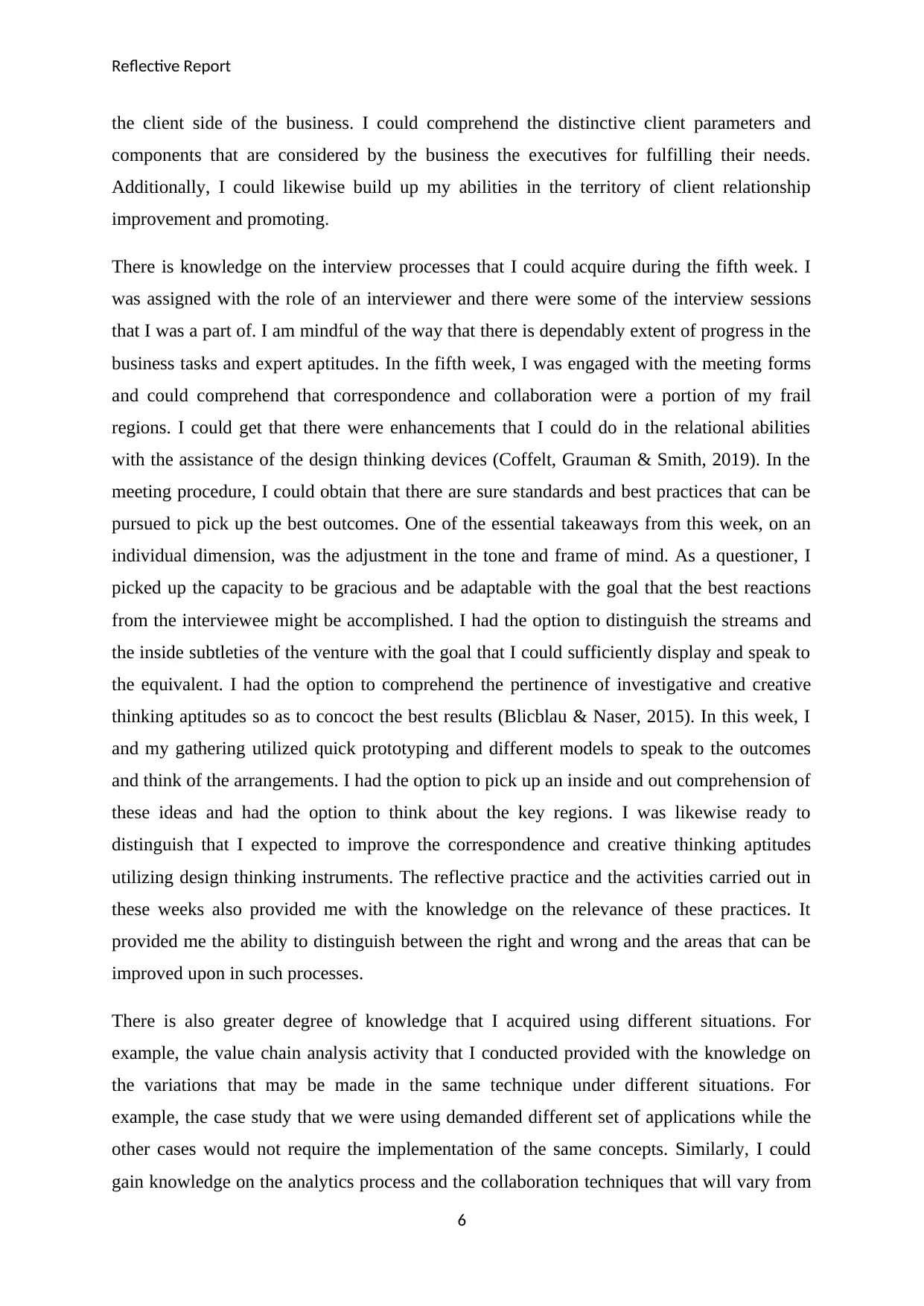
Reflective Report
the client side of the business. I could comprehend the distinctive client parameters and
components that are considered by the business the executives for fulfilling their needs.
Additionally, I could likewise build up my abilities in the territory of client relationship
improvement and promoting.
There is knowledge on the interview processes that I could acquire during the fifth week. I
was assigned with the role of an interviewer and there were some of the interview sessions
that I was a part of. I am mindful of the way that there is dependably extent of progress in the
business tasks and expert aptitudes. In the fifth week, I was engaged with the meeting forms
and could comprehend that correspondence and collaboration were a portion of my frail
regions. I could get that there were enhancements that I could do in the relational abilities
with the assistance of the design thinking devices (Coffelt, Grauman & Smith, 2019). In the
meeting procedure, I could obtain that there are sure standards and best practices that can be
pursued to pick up the best outcomes. One of the essential takeaways from this week, on an
individual dimension, was the adjustment in the tone and frame of mind. As a questioner, I
picked up the capacity to be gracious and be adaptable with the goal that the best reactions
from the interviewee might be accomplished. I had the option to distinguish the streams and
the inside subtleties of the venture with the goal that I could sufficiently display and speak to
the equivalent. I had the option to comprehend the pertinence of investigative and creative
thinking aptitudes so as to concoct the best results (Blicblau & Naser, 2015). In this week, I
and my gathering utilized quick prototyping and different models to speak to the outcomes
and think of the arrangements. I had the option to pick up an inside and out comprehension of
these ideas and had the option to think about the key regions. I was likewise ready to
distinguish that I expected to improve the correspondence and creative thinking aptitudes
utilizing design thinking instruments. The reflective practice and the activities carried out in
these weeks also provided me with the knowledge on the relevance of these practices. It
provided me the ability to distinguish between the right and wrong and the areas that can be
improved upon in such processes.
There is also greater degree of knowledge that I acquired using different situations. For
example, the value chain analysis activity that I conducted provided with the knowledge on
the variations that may be made in the same technique under different situations. For
example, the case study that we were using demanded different set of applications while the
other cases would not require the implementation of the same concepts. Similarly, I could
gain knowledge on the analytics process and the collaboration techniques that will vary from
6
the client side of the business. I could comprehend the distinctive client parameters and
components that are considered by the business the executives for fulfilling their needs.
Additionally, I could likewise build up my abilities in the territory of client relationship
improvement and promoting.
There is knowledge on the interview processes that I could acquire during the fifth week. I
was assigned with the role of an interviewer and there were some of the interview sessions
that I was a part of. I am mindful of the way that there is dependably extent of progress in the
business tasks and expert aptitudes. In the fifth week, I was engaged with the meeting forms
and could comprehend that correspondence and collaboration were a portion of my frail
regions. I could get that there were enhancements that I could do in the relational abilities
with the assistance of the design thinking devices (Coffelt, Grauman & Smith, 2019). In the
meeting procedure, I could obtain that there are sure standards and best practices that can be
pursued to pick up the best outcomes. One of the essential takeaways from this week, on an
individual dimension, was the adjustment in the tone and frame of mind. As a questioner, I
picked up the capacity to be gracious and be adaptable with the goal that the best reactions
from the interviewee might be accomplished. I had the option to distinguish the streams and
the inside subtleties of the venture with the goal that I could sufficiently display and speak to
the equivalent. I had the option to comprehend the pertinence of investigative and creative
thinking aptitudes so as to concoct the best results (Blicblau & Naser, 2015). In this week, I
and my gathering utilized quick prototyping and different models to speak to the outcomes
and think of the arrangements. I had the option to pick up an inside and out comprehension of
these ideas and had the option to think about the key regions. I was likewise ready to
distinguish that I expected to improve the correspondence and creative thinking aptitudes
utilizing design thinking instruments. The reflective practice and the activities carried out in
these weeks also provided me with the knowledge on the relevance of these practices. It
provided me the ability to distinguish between the right and wrong and the areas that can be
improved upon in such processes.
There is also greater degree of knowledge that I acquired using different situations. For
example, the value chain analysis activity that I conducted provided with the knowledge on
the variations that may be made in the same technique under different situations. For
example, the case study that we were using demanded different set of applications while the
other cases would not require the implementation of the same concepts. Similarly, I could
gain knowledge on the analytics process and the collaboration techniques that will vary from
6
Paraphrase This Document
Need a fresh take? Get an instant paraphrase of this document with our AI Paraphraser
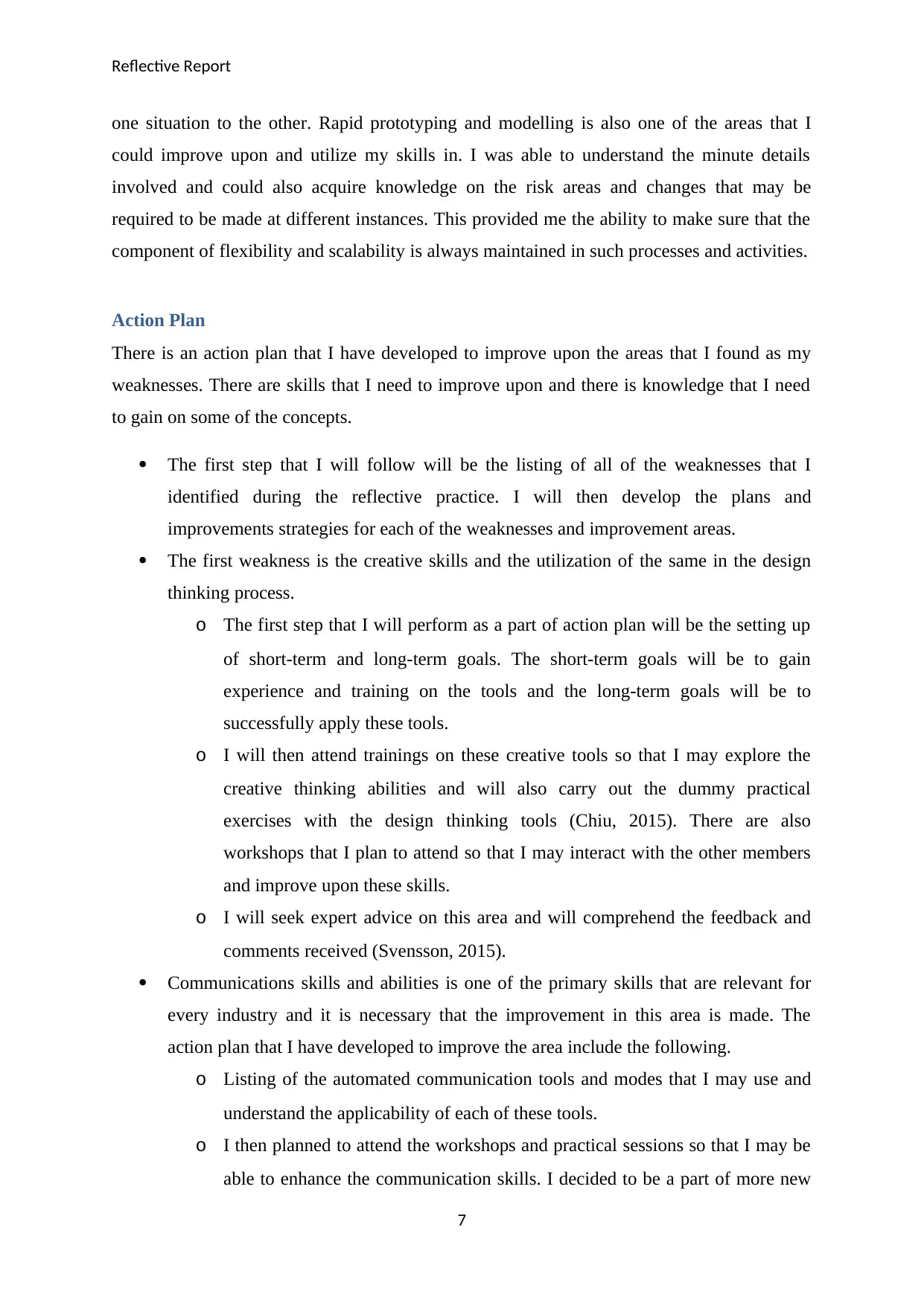
Reflective Report
one situation to the other. Rapid prototyping and modelling is also one of the areas that I
could improve upon and utilize my skills in. I was able to understand the minute details
involved and could also acquire knowledge on the risk areas and changes that may be
required to be made at different instances. This provided me the ability to make sure that the
component of flexibility and scalability is always maintained in such processes and activities.
Action Plan
There is an action plan that I have developed to improve upon the areas that I found as my
weaknesses. There are skills that I need to improve upon and there is knowledge that I need
to gain on some of the concepts.
The first step that I will follow will be the listing of all of the weaknesses that I
identified during the reflective practice. I will then develop the plans and
improvements strategies for each of the weaknesses and improvement areas.
The first weakness is the creative skills and the utilization of the same in the design
thinking process.
o The first step that I will perform as a part of action plan will be the setting up
of short-term and long-term goals. The short-term goals will be to gain
experience and training on the tools and the long-term goals will be to
successfully apply these tools.
o I will then attend trainings on these creative tools so that I may explore the
creative thinking abilities and will also carry out the dummy practical
exercises with the design thinking tools (Chiu, 2015). There are also
workshops that I plan to attend so that I may interact with the other members
and improve upon these skills.
o I will seek expert advice on this area and will comprehend the feedback and
comments received (Svensson, 2015).
Communications skills and abilities is one of the primary skills that are relevant for
every industry and it is necessary that the improvement in this area is made. The
action plan that I have developed to improve the area include the following.
o Listing of the automated communication tools and modes that I may use and
understand the applicability of each of these tools.
o I then planned to attend the workshops and practical sessions so that I may be
able to enhance the communication skills. I decided to be a part of more new
7
one situation to the other. Rapid prototyping and modelling is also one of the areas that I
could improve upon and utilize my skills in. I was able to understand the minute details
involved and could also acquire knowledge on the risk areas and changes that may be
required to be made at different instances. This provided me the ability to make sure that the
component of flexibility and scalability is always maintained in such processes and activities.
Action Plan
There is an action plan that I have developed to improve upon the areas that I found as my
weaknesses. There are skills that I need to improve upon and there is knowledge that I need
to gain on some of the concepts.
The first step that I will follow will be the listing of all of the weaknesses that I
identified during the reflective practice. I will then develop the plans and
improvements strategies for each of the weaknesses and improvement areas.
The first weakness is the creative skills and the utilization of the same in the design
thinking process.
o The first step that I will perform as a part of action plan will be the setting up
of short-term and long-term goals. The short-term goals will be to gain
experience and training on the tools and the long-term goals will be to
successfully apply these tools.
o I will then attend trainings on these creative tools so that I may explore the
creative thinking abilities and will also carry out the dummy practical
exercises with the design thinking tools (Chiu, 2015). There are also
workshops that I plan to attend so that I may interact with the other members
and improve upon these skills.
o I will seek expert advice on this area and will comprehend the feedback and
comments received (Svensson, 2015).
Communications skills and abilities is one of the primary skills that are relevant for
every industry and it is necessary that the improvement in this area is made. The
action plan that I have developed to improve the area include the following.
o Listing of the automated communication tools and modes that I may use and
understand the applicability of each of these tools.
o I then planned to attend the workshops and practical sessions so that I may be
able to enhance the communication skills. I decided to be a part of more new
7
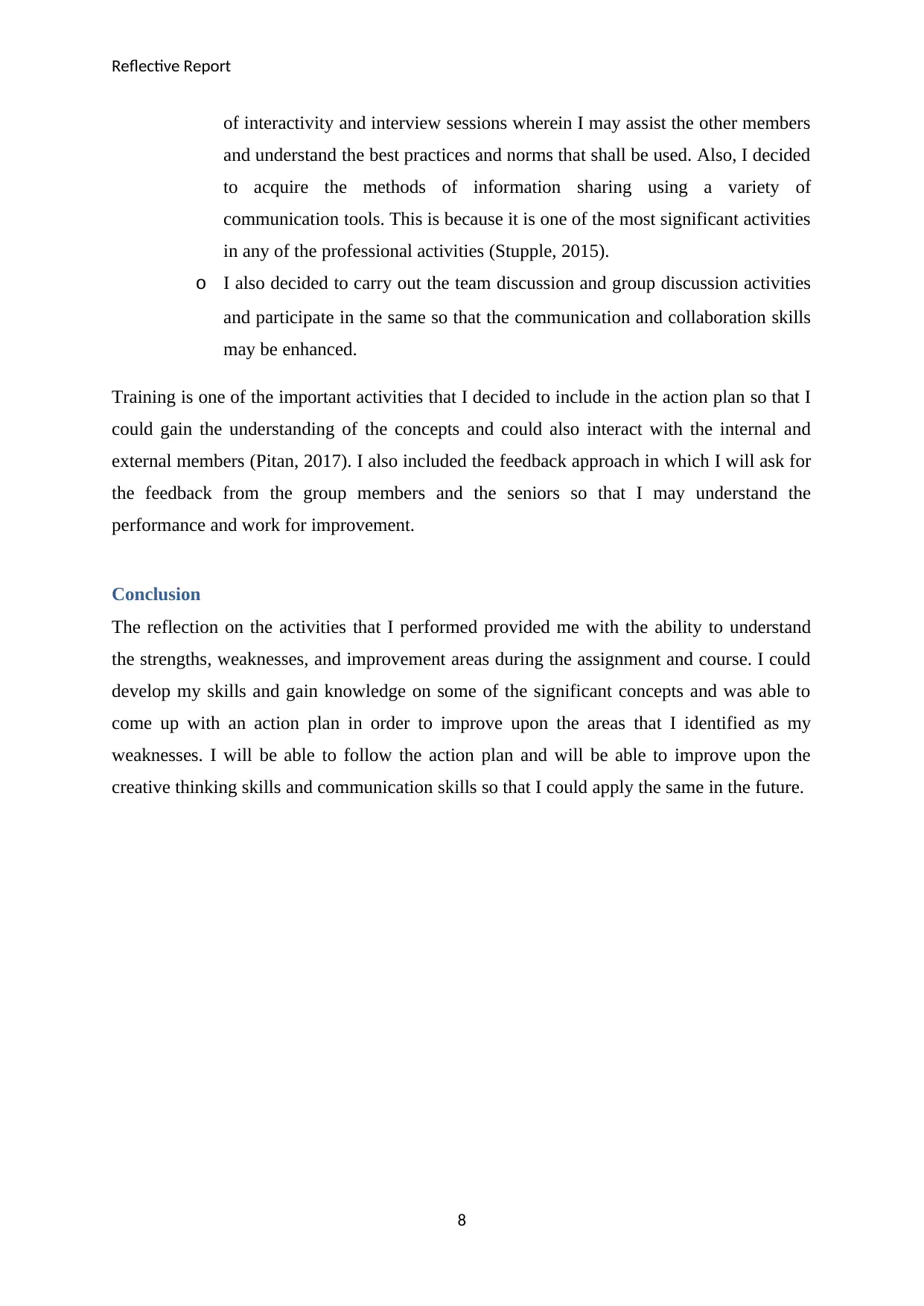
Reflective Report
of interactivity and interview sessions wherein I may assist the other members
and understand the best practices and norms that shall be used. Also, I decided
to acquire the methods of information sharing using a variety of
communication tools. This is because it is one of the most significant activities
in any of the professional activities (Stupple, 2015).
o I also decided to carry out the team discussion and group discussion activities
and participate in the same so that the communication and collaboration skills
may be enhanced.
Training is one of the important activities that I decided to include in the action plan so that I
could gain the understanding of the concepts and could also interact with the internal and
external members (Pitan, 2017). I also included the feedback approach in which I will ask for
the feedback from the group members and the seniors so that I may understand the
performance and work for improvement.
Conclusion
The reflection on the activities that I performed provided me with the ability to understand
the strengths, weaknesses, and improvement areas during the assignment and course. I could
develop my skills and gain knowledge on some of the significant concepts and was able to
come up with an action plan in order to improve upon the areas that I identified as my
weaknesses. I will be able to follow the action plan and will be able to improve upon the
creative thinking skills and communication skills so that I could apply the same in the future.
8
of interactivity and interview sessions wherein I may assist the other members
and understand the best practices and norms that shall be used. Also, I decided
to acquire the methods of information sharing using a variety of
communication tools. This is because it is one of the most significant activities
in any of the professional activities (Stupple, 2015).
o I also decided to carry out the team discussion and group discussion activities
and participate in the same so that the communication and collaboration skills
may be enhanced.
Training is one of the important activities that I decided to include in the action plan so that I
could gain the understanding of the concepts and could also interact with the internal and
external members (Pitan, 2017). I also included the feedback approach in which I will ask for
the feedback from the group members and the seniors so that I may understand the
performance and work for improvement.
Conclusion
The reflection on the activities that I performed provided me with the ability to understand
the strengths, weaknesses, and improvement areas during the assignment and course. I could
develop my skills and gain knowledge on some of the significant concepts and was able to
come up with an action plan in order to improve upon the areas that I identified as my
weaknesses. I will be able to follow the action plan and will be able to improve upon the
creative thinking skills and communication skills so that I could apply the same in the future.
8
⊘ This is a preview!⊘
Do you want full access?
Subscribe today to unlock all pages.

Trusted by 1+ million students worldwide
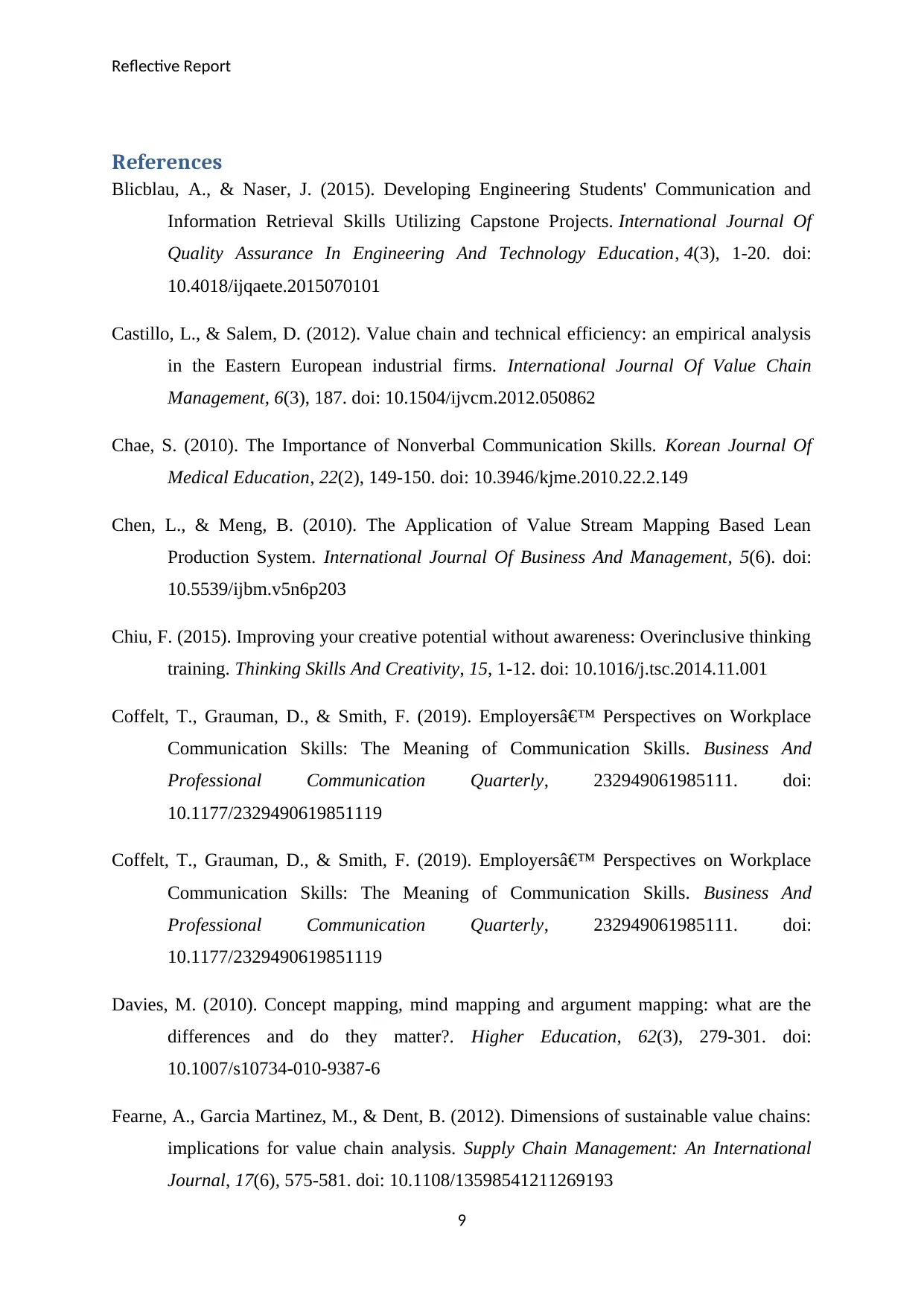
Reflective Report
References
Blicblau, A., & Naser, J. (2015). Developing Engineering Students' Communication and
Information Retrieval Skills Utilizing Capstone Projects. International Journal Of
Quality Assurance In Engineering And Technology Education, 4(3), 1-20. doi:
10.4018/ijqaete.2015070101
Castillo, L., & Salem, D. (2012). Value chain and technical efficiency: an empirical analysis
in the Eastern European industrial firms. International Journal Of Value Chain
Management, 6(3), 187. doi: 10.1504/ijvcm.2012.050862
Chae, S. (2010). The Importance of Nonverbal Communication Skills. Korean Journal Of
Medical Education, 22(2), 149-150. doi: 10.3946/kjme.2010.22.2.149
Chen, L., & Meng, B. (2010). The Application of Value Stream Mapping Based Lean
Production System. International Journal Of Business And Management, 5(6). doi:
10.5539/ijbm.v5n6p203
Chiu, F. (2015). Improving your creative potential without awareness: Overinclusive thinking
training. Thinking Skills And Creativity, 15, 1-12. doi: 10.1016/j.tsc.2014.11.001
Coffelt, T., Grauman, D., & Smith, F. (2019). Employers’ Perspectives on Workplace
Communication Skills: The Meaning of Communication Skills. Business And
Professional Communication Quarterly, 232949061985111. doi:
10.1177/2329490619851119
Coffelt, T., Grauman, D., & Smith, F. (2019). Employers’ Perspectives on Workplace
Communication Skills: The Meaning of Communication Skills. Business And
Professional Communication Quarterly, 232949061985111. doi:
10.1177/2329490619851119
Davies, M. (2010). Concept mapping, mind mapping and argument mapping: what are the
differences and do they matter?. Higher Education, 62(3), 279-301. doi:
10.1007/s10734-010-9387-6
Fearne, A., Garcia Martinez, M., & Dent, B. (2012). Dimensions of sustainable value chains:
implications for value chain analysis. Supply Chain Management: An International
Journal, 17(6), 575-581. doi: 10.1108/13598541211269193
9
References
Blicblau, A., & Naser, J. (2015). Developing Engineering Students' Communication and
Information Retrieval Skills Utilizing Capstone Projects. International Journal Of
Quality Assurance In Engineering And Technology Education, 4(3), 1-20. doi:
10.4018/ijqaete.2015070101
Castillo, L., & Salem, D. (2012). Value chain and technical efficiency: an empirical analysis
in the Eastern European industrial firms. International Journal Of Value Chain
Management, 6(3), 187. doi: 10.1504/ijvcm.2012.050862
Chae, S. (2010). The Importance of Nonverbal Communication Skills. Korean Journal Of
Medical Education, 22(2), 149-150. doi: 10.3946/kjme.2010.22.2.149
Chen, L., & Meng, B. (2010). The Application of Value Stream Mapping Based Lean
Production System. International Journal Of Business And Management, 5(6). doi:
10.5539/ijbm.v5n6p203
Chiu, F. (2015). Improving your creative potential without awareness: Overinclusive thinking
training. Thinking Skills And Creativity, 15, 1-12. doi: 10.1016/j.tsc.2014.11.001
Coffelt, T., Grauman, D., & Smith, F. (2019). Employers’ Perspectives on Workplace
Communication Skills: The Meaning of Communication Skills. Business And
Professional Communication Quarterly, 232949061985111. doi:
10.1177/2329490619851119
Coffelt, T., Grauman, D., & Smith, F. (2019). Employers’ Perspectives on Workplace
Communication Skills: The Meaning of Communication Skills. Business And
Professional Communication Quarterly, 232949061985111. doi:
10.1177/2329490619851119
Davies, M. (2010). Concept mapping, mind mapping and argument mapping: what are the
differences and do they matter?. Higher Education, 62(3), 279-301. doi:
10.1007/s10734-010-9387-6
Fearne, A., Garcia Martinez, M., & Dent, B. (2012). Dimensions of sustainable value chains:
implications for value chain analysis. Supply Chain Management: An International
Journal, 17(6), 575-581. doi: 10.1108/13598541211269193
9
Paraphrase This Document
Need a fresh take? Get an instant paraphrase of this document with our AI Paraphraser
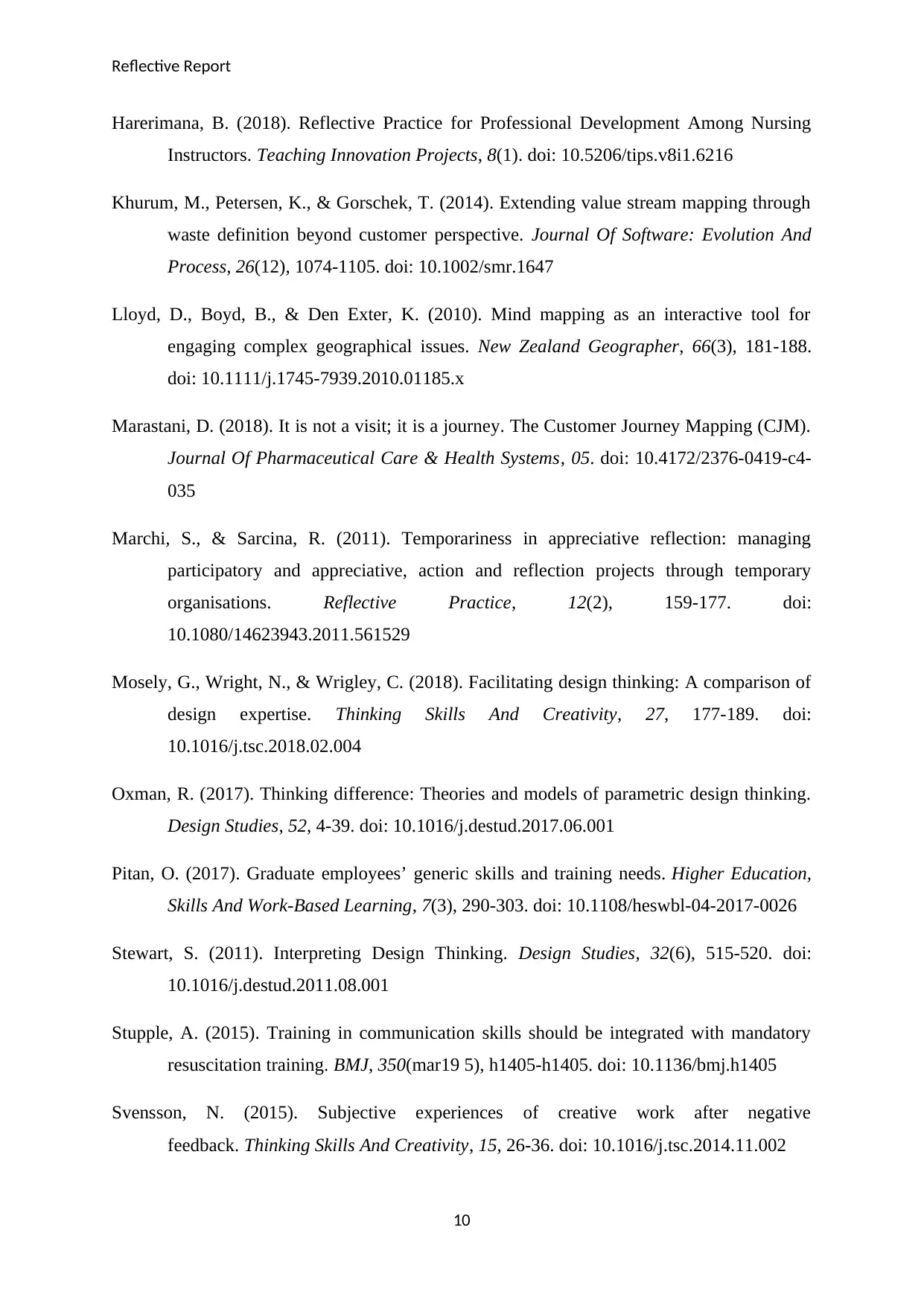
Reflective Report
Harerimana, B. (2018). Reflective Practice for Professional Development Among Nursing
Instructors. Teaching Innovation Projects, 8(1). doi: 10.5206/tips.v8i1.6216
Khurum, M., Petersen, K., & Gorschek, T. (2014). Extending value stream mapping through
waste definition beyond customer perspective. Journal Of Software: Evolution And
Process, 26(12), 1074-1105. doi: 10.1002/smr.1647
Lloyd, D., Boyd, B., & Den Exter, K. (2010). Mind mapping as an interactive tool for
engaging complex geographical issues. New Zealand Geographer, 66(3), 181-188.
doi: 10.1111/j.1745-7939.2010.01185.x
Marastani, D. (2018). It is not a visit; it is a journey. The Customer Journey Mapping (CJM).
Journal Of Pharmaceutical Care & Health Systems, 05. doi: 10.4172/2376-0419-c4-
035
Marchi, S., & Sarcina, R. (2011). Temporariness in appreciative reflection: managing
participatory and appreciative, action and reflection projects through temporary
organisations. Reflective Practice, 12(2), 159-177. doi:
10.1080/14623943.2011.561529
Mosely, G., Wright, N., & Wrigley, C. (2018). Facilitating design thinking: A comparison of
design expertise. Thinking Skills And Creativity, 27, 177-189. doi:
10.1016/j.tsc.2018.02.004
Oxman, R. (2017). Thinking difference: Theories and models of parametric design thinking.
Design Studies, 52, 4-39. doi: 10.1016/j.destud.2017.06.001
Pitan, O. (2017). Graduate employees’ generic skills and training needs. Higher Education,
Skills And Work-Based Learning, 7(3), 290-303. doi: 10.1108/heswbl-04-2017-0026
Stewart, S. (2011). Interpreting Design Thinking. Design Studies, 32(6), 515-520. doi:
10.1016/j.destud.2011.08.001
Stupple, A. (2015). Training in communication skills should be integrated with mandatory
resuscitation training. BMJ, 350(mar19 5), h1405-h1405. doi: 10.1136/bmj.h1405
Svensson, N. (2015). Subjective experiences of creative work after negative
feedback. Thinking Skills And Creativity, 15, 26-36. doi: 10.1016/j.tsc.2014.11.002
10
Harerimana, B. (2018). Reflective Practice for Professional Development Among Nursing
Instructors. Teaching Innovation Projects, 8(1). doi: 10.5206/tips.v8i1.6216
Khurum, M., Petersen, K., & Gorschek, T. (2014). Extending value stream mapping through
waste definition beyond customer perspective. Journal Of Software: Evolution And
Process, 26(12), 1074-1105. doi: 10.1002/smr.1647
Lloyd, D., Boyd, B., & Den Exter, K. (2010). Mind mapping as an interactive tool for
engaging complex geographical issues. New Zealand Geographer, 66(3), 181-188.
doi: 10.1111/j.1745-7939.2010.01185.x
Marastani, D. (2018). It is not a visit; it is a journey. The Customer Journey Mapping (CJM).
Journal Of Pharmaceutical Care & Health Systems, 05. doi: 10.4172/2376-0419-c4-
035
Marchi, S., & Sarcina, R. (2011). Temporariness in appreciative reflection: managing
participatory and appreciative, action and reflection projects through temporary
organisations. Reflective Practice, 12(2), 159-177. doi:
10.1080/14623943.2011.561529
Mosely, G., Wright, N., & Wrigley, C. (2018). Facilitating design thinking: A comparison of
design expertise. Thinking Skills And Creativity, 27, 177-189. doi:
10.1016/j.tsc.2018.02.004
Oxman, R. (2017). Thinking difference: Theories and models of parametric design thinking.
Design Studies, 52, 4-39. doi: 10.1016/j.destud.2017.06.001
Pitan, O. (2017). Graduate employees’ generic skills and training needs. Higher Education,
Skills And Work-Based Learning, 7(3), 290-303. doi: 10.1108/heswbl-04-2017-0026
Stewart, S. (2011). Interpreting Design Thinking. Design Studies, 32(6), 515-520. doi:
10.1016/j.destud.2011.08.001
Stupple, A. (2015). Training in communication skills should be integrated with mandatory
resuscitation training. BMJ, 350(mar19 5), h1405-h1405. doi: 10.1136/bmj.h1405
Svensson, N. (2015). Subjective experiences of creative work after negative
feedback. Thinking Skills And Creativity, 15, 26-36. doi: 10.1016/j.tsc.2014.11.002
10
1 out of 11
Related Documents
Your All-in-One AI-Powered Toolkit for Academic Success.
+13062052269
info@desklib.com
Available 24*7 on WhatsApp / Email
![[object Object]](/_next/static/media/star-bottom.7253800d.svg)
Unlock your academic potential
Copyright © 2020–2025 A2Z Services. All Rights Reserved. Developed and managed by ZUCOL.




